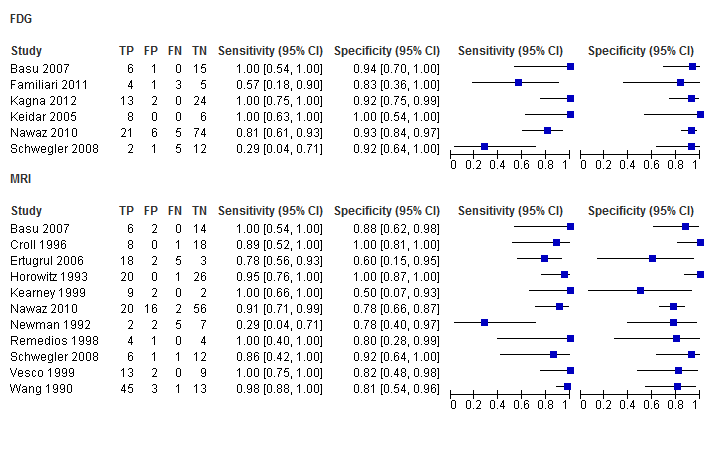Poster Presentation The Annual Scientific Meeting of the Australian Diabetes Society and the Australian Diabetes Educators Association 2013
A meta-analysis of FDG PET/CT versus MRI in diagnosing diabetic foot osteomyelitis (#354)
AIM: Bone infection underlying diabetic foot ulcers requires accurate diagnosis to optimise management given substantial impact on patient morbidity, quality-of-life and healthcare costs. MRI is now the imaging modality of choice however, there is an increasing interest in the diagnostic performance of (18)F-fluoro-2-deoxyglucose positron emission tomography with computed tomography (FDG PET/CT) in detecting infection. The aim of this meta-analysis is to compare the diagnostic performance of FDG PET/CT with MRI in detecting diabetic foot ulcer osteomyelitis.
METHODS: PubMed/MEDLINE and Embase databases were searched systematically for relevant MRI and FDG PET/CT studies. Two reviewers independently assessed the methodological quality of each study. Studies that were unable to provide per-patient level data were excluded. A meta-analysis of the reported sensitivity and specificity of each study was performed.
RESULTS: The inclusion criteria were met by 3 FDG PET/CT studies, 8 MRI studies and 3 studies with both PET/CT and MRI; there was a total sample size of 214 patients in the FDG PET/CT studies. Overall, the studies had reasonable methodological quality. Pooled sensitivity and specificity of FDG-PET were 80.6% (95%CI = 69.1-89.2%) and 92.5% (95%CI = 87.0-96.2%), respectively. Sensitivity but not specificity was heterogeneous amongst individual FDG PET/CT studies (I-Square = 77.8%). Pooled sensitivity and specificity of MRI were 90.4% (95%CI = 84.9-94.4%) and 84.1% (95%CI = 78.2-88.9%). MRI studies were more heterogeneous in terms of sensitivity (I-Square 67%) and specificity (I-Square =56%).
 Fig.1. Forest plot of sensitivity and specificity of individual studies
Fig.1. Forest plot of sensitivity and specificity of individual studies
 Fig. 2. Summary Receiver Operating Characteristic curves
Fig. 2. Summary Receiver Operating Characteristic curves
CONCLUSION: Overall diagnostic performance of FDG PET/CT is comparable to MRI, which are both accurate. FDG PET/CT may be more specific than MRI in patients with Charcot's osteoarthropathy. There is significant heterogeneity in terms of sensitivity for FDG PET/CT and both sensitivity and specificity for MRI studies, and therefore larger scale studies for direct comparison are warranted.